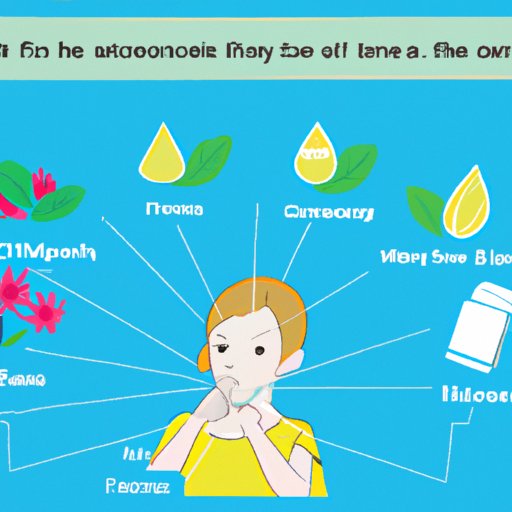Introduction
Flonase is a nasal spray that is used to treat the symptoms of allergies such as nasal congestion, sneezing, and itching. It is a corticosteroid that helps reduce inflammation in the nasal passages and prevents allergic reactions from occurring. This article will explore how Flonase works and how it can be used to provide relief from allergy symptoms.
Explaining the Science Behind Flonase: How Does it Work?
Flonase is a type of steroid medication known as a corticosteroid. Corticosteroids are hormones produced naturally by the body and help regulate various bodily functions. When taken as a medication, these hormones can help reduce inflammation in the body. In the case of Flonase, they work to reduce inflammation of the nasal passages, which can help relieve symptoms of allergies such as congestion, sneezing, and itching.
According to a study published in the journal Allergy, Asthma & Clinical Immunology, Flonase works by blocking the release of histamine and other inflammatory substances in the body. Histamine is a chemical released by the immune system when it senses an allergen, which can cause the symptoms of an allergic reaction. By blocking the release of histamine, Flonase can prevent allergic reactions from occurring and reduce inflammation in the nasal passages.
What is Flonase and How Does it Treat Allergies?
Flonase is used to treat the symptoms of allergies such as nasal congestion, sneezing, itching, and watery eyes. It can also help reduce swelling in the nasal passages, which can make it easier to breathe. It is most commonly used to treat hay fever, but it can also be used to treat other types of allergies such as pet allergies and dust allergies.
It is important to note that Flonase does not cure allergies, but rather treats the symptoms associated with them. If you have allergies, it is best to consult a doctor to determine the best course of treatment.
Understanding How Flonase Treats Nasal Symptoms
Flonase works by reducing inflammation in the nasal passages, which can help reduce symptoms such as congestion, sneezing, and itching. It can also help reduce swelling in the nasal passages, making it easier to breathe. While Flonase is generally safe to use, there are some potential side effects such as headache, throat irritation, and nosebleeds.
In addition, it is important to note that Flonase may interact with other medications, so it is important to discuss any medications you are taking with your doctor before using Flonase. Finally, it is important to follow the instructions on the label when using Flonase.

The Pros and Cons of Taking Flonase
Taking Flonase can provide relief from allergy symptoms such as congestion, sneezing, and itching. It can also help reduce swelling in the nasal passages, making it easier to breathe. Additionally, Flonase is generally safe to use and has few side effects.
However, there are some potential risks associated with taking Flonase. These include nosebleeds, headaches, and throat irritation. Additionally, Flonase may interact with other medications, so it is important to discuss any medications you are taking with your doctor before using Flonase.

Flonase: An Overview of Its Effects and Benefits
Flonase usually begins working within 12 hours of taking it. The effects of Flonase can last up to 24 hours, but this varies depending on the individual. It is important to note that it may take several days of consistent use before the full effects of Flonase are felt.

What You Need to Know About Flonase
Flonase is generally safe to use during pregnancy and while breastfeeding. However, it is important to discuss any medications you are taking with your doctor before using Flonase. Additionally, Flonase may interact with certain medications, so it is important to talk to your doctor about any potential drug interactions.
A Guide to Using Flonase for Allergy Relief
Using Flonase correctly is key to achieving the best results. It is important to follow the instructions on the label when using Flonase. Additionally, it is important to use Flonase consistently in order to get the most benefit from it. Other measures that can be taken to reduce allergy symptoms include avoiding allergens, using a humidifier, and washing bedding regularly.
Conclusion
Flonase is a nasal spray that is used to treat the symptoms of allergies such as nasal congestion, sneezing, and itching. It works by reducing inflammation in the nasal passages and preventing allergic reactions from occurring. It is generally safe to use and has few side effects, although there are some potential risks associated with taking Flonase. It is important to follow the instructions on the label when using Flonase and to talk to your doctor about any potential drug interactions.
In conclusion, Flonase is a safe and effective way to treat the symptoms of allergies. It can provide relief from congestion, sneezing, and itching, and can help reduce swelling in the nasal passages. By understanding how Flonase works and how to properly use it, you can get the most benefit from this medication.
(Note: Is this article not meeting your expectations? Do you have knowledge or insights to share? Unlock new opportunities and expand your reach by joining our authors team. Click Registration to join us and share your expertise with our readers.)
